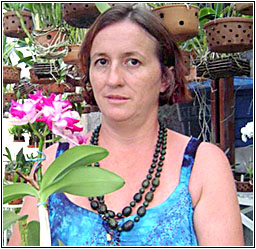 |
Apolônia
Grade, 43 years old, was born in Cascavel, state of Parana but lives
in Alta Floresta, in the extreme north of the state of Mato Grosso
(800km far from Cuiabá), since its foundation in 1977.
Her family is pioneer in the colonization of the north of this state.
Biologist and Environmental teacher, she is an active member in
the conservation of fauna and flora of her region specially through
a pacific man insertion in the environment and preserving the human
condition and by respecting the space and the nature.
She has been cultivating orchids since 15 years.
Learn with her how to be a Catasetum successful grower. |
|
I
started to cultivate orchids 15 years ago. My daughter was a baby
and the nurse gave me a plant. It was a Cattleya forbesii,
when it bloomed, I called a friend of mine to see it. It has been
exactly taken from her! rsrs.
I became fascinated with catasetuns. My firsts plants were already
turning to be a "embryo" of a collection when we clean
up a waste land in the backyard of our home. A gang of starving
large brown rats devoured all my catasetineas in a few days!!!
We gave great chase: between the pots, under the staging, holes
and cavities on the outside wall, 54 big rats!!! |
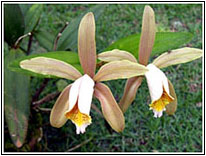 Cattleya
forbesii
Cattleya
forbesii |
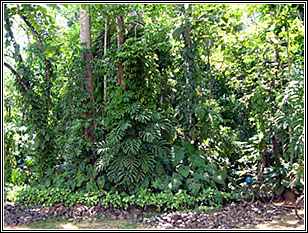
Amazon
Forest
|
Little
by little, I received plants as gift... I used to fish a lot with
my husband through the rivers of the region and always come back
with some plants. My back yard became small. There was no place
to kids playing nor orchids growing. We moved to this ranch and
here we have an area with 24.000m2 with a third of virgin forest
- true Amazon forest. And the back, a lake. Wonderful space.
The first orchid nursery built here, 10 x 5m, "was enough"
for some years, but as it is next to the wood, it is too shady.
It became a Bromeliaceae nursery.
Far from any orchid circle, the closest commercial nursery is located
in Campo Grande, it means almost 2.000 km far from here, many times
I acted an "orchid killer" instead of being a collector.
Just for lacking of experience. |
|
Trying
to improve my self, I decided to go to the university school.
With two small kids, working out I decided to study at night. BIOLOGY
at the local University. Many times I attend the classes with youngest
child sleeping in the baby carriage next to me, and the first born
drawing seat on the mattress.
By the end of the course, we were four biologists at home: my husband
who did the works, researches, went with me to the field classes
and the kids who attend the course with me.
But I graduated in MONOLOGY, it means, biologist of just a subject:
orchids.
The cares and respect to the nature, we always have, soon we started
to be rewarded by the fauna of the region: cutias (Dasyprocta
aguti) eat and playing in the back yard, alligators taking sun-bath
at the edge, capivaras (water cavy, capybara)
graze and devour orchids, monkeys rob the fruits from our breakfast...
|
|
|
|
| Capivara
- admiring the flowers or posing?
|
Nest
of
Bem-te-vi (Myiozetetes similis) in the pen-work baskets of
Catasetum - be careful with the control of the cultural ailments,
do not use toxic products. |
O
Galo-de-Campina (Paroaria dominicana) is always around.
|
|
The
dazzle with catasetuns increased and a new nursery got the appropriated
name of "Catasetum nursery" .
Those plants are very abundant in the region, they grow vigorous
in the palms on the pastures. They finish for becoming cows ration.
And our orchidists called them "parasites" or even "carnivores",
due to the fact that the male flowers discharge their pollinia when
they are touched. |
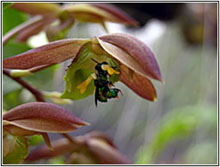
Ctsm juruenense |
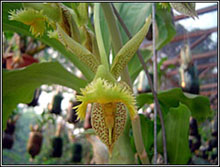
Ctsm fimbriatum |
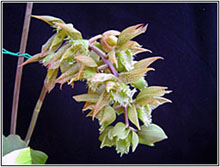
Ctsm appendiculatum |
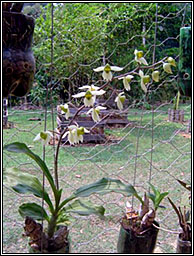
Ctsm albovirens |
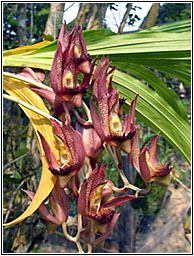
Catasetum schmidtianum |
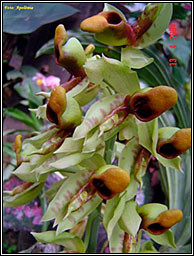
Ctsm galeritum |
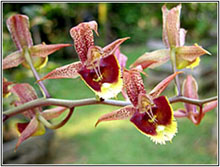
Ctsm (appendiculatum
x João Stivalli)
|
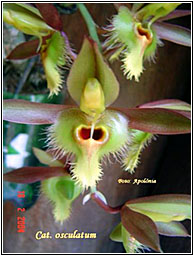
Ctsm osculatum |
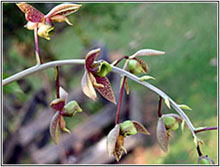
Ctsm confusum |
Any
kind of reproduction (print, digital or anyone) of any type of material
of this site: texts, layout, photos, images and others - is
strictly forbidden without previous written permission of the authors.
Any solicitation or information by the e-mail: bo@sergioaraujo.com |


|